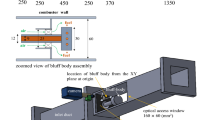Abstract
This paper is devoted to the general question of the effect of chemical reactions taking place in the boundary layer with the release of heat on the heat transfer, mass transfer, and friction. In the most general formulation the problem is associated with extremely complex computations because of the presence of many components in the mixture of gases. Moreover, to date the chemical kinetics have received little study, and there are simply no reliable data that can be used in the calculations. Therefore we consider in the following a simplified case in which the chemical reaction proceeds in an infinitely narrow region-a flame front. Mathematically this front is a surface of discontinuity of the concentration and temperature derivatives. Physically this corresponds to the limiting case of chemical equilibrium, in which equilibrium occurs with complete combustion and is realized at moderate temperatures and quite high pressures.
This formulation of the problem simplifies the calculation considerably, since the gas mixture may be considered everywhere binary. In this case it is not necessary to introduce into consideration either the chemical kinetics or the chemical equilibrium constants. Moreover, in the case of this formulation we may make use of a similar solution of the boundary layer equations. The extreme simplification of the computations does not alter the physical essence of the problem-the effect of the heat sources within the boundary layer on friction, heat transfer and mass transfer. A large number of computations was made to permit clarification of the specific nature of the dependences of the coefficients of friction, and heat and mass transfer on the rate of fuel injection.
Several studies have been published in which a similar assumption was made. Avduevskii and Obroskova [1] consider the case when the flame front is located right at the wall. Harnett and Eckert [2] calculated the boundary layer for a flame front on the assumption that the physical parameters do not depend on temperature. This assumption gives a picture which is inaccurate both quantitatively and qualitatively. Finally, when the present study was nearly completed, the article of Libby and Pierucci [3] appeared. In that study the external flow (air) is a mixture of oxygen and an inert gas (argon). Therefore there is a three-component mixture in the boundary layer at every point. This significantly complicates the computation. At the same time, the dependence of the physical parameters on temperature and the concentrations of the mixture components is taken in simplified form (an unjustified simplification, in our view). The authors of [3] carried out only a limited number of computations, which did not make it possible to clarify the characteristic features of the variation of the friction, heat transfer, and mass transfer coefficients as a function of the rate of combustible gas injection.
Similar content being viewed by others
Abbreviations
- x:
-
coordinate along plate in flow direction
- y:
-
coordinate along normal to plate
- u, v:
-
velocity components
- T:
-
absolute temperature
- c:
-
mass concentration
- γ:
-
volume concentration
- ρ:
-
density
- cp :
-
specific heat at constant pressure
- μ:
-
viscosity coefficient
- D:
-
diffusion coefficient
- h:
-
specific enthalpy
- λ:
-
heat conductivity
- M:
-
Mach number in external stream
- k:
-
adiabatic exponent in external stream
References
V. S. Avduevskii and E. I. Obroskova, “Laminar boundary layer on a porous plate with chemical reactions on the surface,” Izv. AN SSSR, OTN, Mekhanika i mashinostroenie, no. 5, 1962.
J. P. Harnett and E. R. G. Eckert, “Mass transfer cooling with combustion in a laminar boundary layer,” Proceedings of the Heat Transfer and Fluid Mechanics Institute, Stanford University Press, 1958.
P. A. Libby and M. Pierucci, “Laminar boundary layer with hydrogen injection including multicomponent diffusion,” AIAA J., vol. 2, no. 12, 1964.
M. Kh. Karapet'yants, Chemical Thermodynamics [in Russian], Goskhimizdat, 1953.
A. S. Shifrin, “Viscosity of water vapor at atmospheric pressure,” Teploenergetika, no. 9, 1959.
J. D. Hirschfelder, C. F. Curtiss, and R. B. Bird, Molecular Theory of Gases and Liquids [Russian translation], Izd. inostr. lit., 1961.
N. B. Vargaftik, Handbook on Thermophysical Properties of Gases and Liquids [in Russian], Fizmatgiz, 1963.
L. G. Loitsyanskii, The Laminar Boundary Layer [in Russian], Fizmatgiz, 1962.
V. S. Avduevskii, Laminar Boundary Layer in a Compressible Gas on Porous or Permeable Surface with Small Longitudinal Pressure Gradients [in Russian], Oborongiz, 1956.
Author information
Authors and Affiliations
Additional information
The author wishes to thank V. S. Avduevskii for guiding this investigation.
Rights and permissions
About this article
Cite this article
Ruskol, V.A. Similar solution of laminar boundary layer equations with a flame front. Fluid Dyn 1, 5–10 (1966). https://doi.org/10.1007/BF01013805
Issue Date:
DOI: https://doi.org/10.1007/BF01013805




